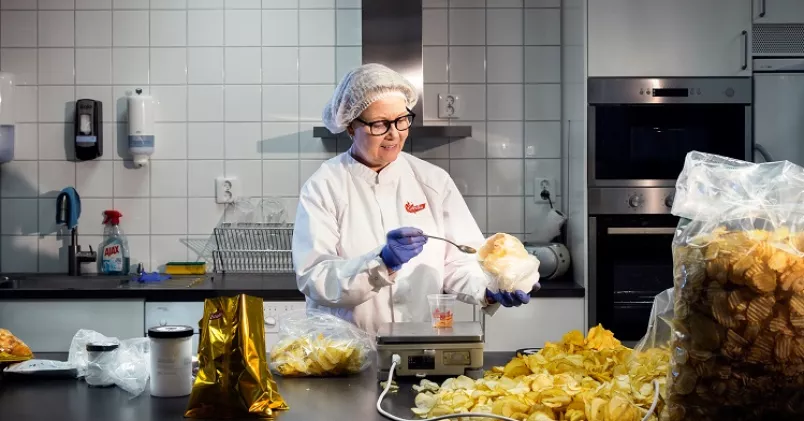
Hur hamnade du på Estrella?
– Jag är utbildad hemkunskapslärare och har alltid haft ett stort intresse för matlagning och smak. Det kan vara svårt att tänka sig nu, men 1987 var det ont om lärarjobb och jag sökte säkert 50 tjänster innan jag såg en annons där Estrella sökte en produktutvecklare. Jag har kvar samma tjänst, men uppgifterna har ändrat sig mycket sedan dess.
Vad är det bästa med ditt jobb?
– Att jag får vara kreativ och innovativ. Jag känner verkligen att man litar på min kunskap. Vi är tre produktutvecklare i Göteborg och tre på vårt bolag i Norge, det är verkligen ett samarbete.
Hur får ni fram en ny smak?
– Vi börjar med att ta fram ett antal olika smakinriktningar för den produkt som ska lanseras ett år senare. Vi inspireras av allt från trender i krogvärlden till önskemål från våra kunder. I samarbete med våra leverantörer tar vi sedan fram kryddblandningar som vi testar, justerar och diskuterar oss fram till några smaker som vi är nöjda med. Det blir mycket smakande! Till slut får en panel med konsumenter tycka till.
Vilken är den största utmaningen?
– Att skapa balans. Du vill få till en bra start som gör smaken spännande, den ska vara saftig och ha en fyllighet och på slutet ge en ”lagom” eftersmak som inte dör av för snabbt. Man ska inte bli mätt på smaken efter tre chips.
Vilken smak är du mest stolt över?

– Jag var med och tog fram sourcream & onion på 80-talet som spred sig över hela Europa. Våra säljare hade hittat en variant i USA, men den var ganska smörig. Vi sökte något som kunde passa här och när jag lade till mer gräddfil gifte sig syran och löken. Det blev en omedelbar succé, vi nådde personer som aldrig brukade äta chips.
Har du gjort några mindre lyckade produkter?
– Smak är subjektivt och det är inte alltid mina favoriter som lanseras. Ibland har vi satsat på ”snackisar” som smak av varma mackor och äpplepaj. Ärligt talat tyckte jag chipsen med hamburgarsmak var ”så där”.
Äter du mycket chips på fritiden?
– Det kan bli lite mycket av det på jobbet så jag äter mer jordnötsringar och nötter hemma. Men det är en viktig del i jobbet att exempelvis testa konkurrenternas sortiment.
Hur ser du på hälsoaspekten med snacks?
– Man ska äta allt med måtta, men jag tycker att chips har oförtjänt dåligt rykte. De innehåller vitaminer, vegetabiliska fetter, fibrer och proteiner.
5 saker du inte visste om chipstilverkning
- Under 2023 konsumerade svenska folket 266 911 120 påsar snacks. Den genomsnittliga svensken äter cirka 5,8 kilo per år, nionde högst i Europa.
- Vid Estrellas fabrik i Angered utanför Göteborg tillverkas årligen strax under 24 000 ton snacks. Här finns också huvudkontor och produktutveckling.
- Det går åt nära fyra kilo potatis till ett kilo chips. Rå potatis innehåller en stor del vatten som ångas bort under tillverkningsprocessen.
- Estrellas grundare Folke Andersson har en arena uppkallad efter sig i Ecuador: Estadio Folke Anderson, som rymmer 14 000 människor.
- 22 minuter. Så lång tid tar det för potatisen att förvandlas till ett färdigt chips i fabriken. Knölen sorteras, tvättas och skivas innan den friteras i 175 gradig olja. Därefter åker chipsen genom en stor trumma som fördelar kryddblandningen jämnt.

ESTRELLA
- 267 anställda, från 20 olika länder. De flesta arbetar vid anläggningen i Angered utanför Göteborg.
- Bolaget grundades 1946 av Folke Andersson. De första åren importerades bananer från Sydamerika. Produktion av chips och popcorn inleddes 1957.
- Unionenklubben på Estrella har 77 medlemmar.













